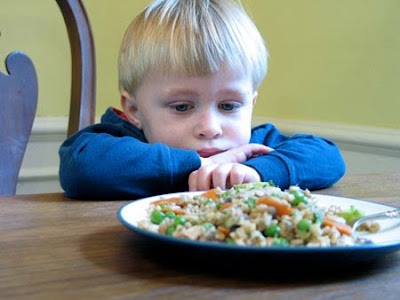This is a guest post by Jenna, who blogs at Food with Kid Appeal with a focus on healthy cooking and an amazing knack for helping all parents inspire kids to try new foods. For more tips, check out Jenna’s list of 15 common feeding problems.
I polled my readers to find out the 5 most common reasons why kids to opt out of food. Next to each one I’ve suggested some responses you can practice saying. When the window of opportunity presents itself you’ll have something more effective to say than “just try it.”
Sight alone, food refusals purely from looking at the dish, was on the top of the list. The unfortunate thing here is that most young kids don’t have enough frame of reference to use sight as a reliable indicator of taste appeal. That builds over time as they associate more colors, shapes and food presentations that do taste good.
Objection: “I don’t want that, it’s too pointy“
Response: “That is an interesting way to describe the way the pomegranate aril looks. Can you taste it and describe the way it tastes in an interesting way?“
The second most common reason food was rejected was due to a new recipe or inclusion of a new ingredient. Even preparing an accepted food in a new dish can cause complaints
Objection: “What is that? I don’t want it?“
Response “I bet this is not what you were expecting for dinner tonight. This is a new recipe, let’s taste it and see if it’s a recipe we want to make again. On a scale of 1- 10, I give it a 6. It’s got a good flavor. I’d eat it again, but I wouldn’t want it every night. What do you think?”
Mixed up dishes was third in rank for most common cause of food rejection. Casseroles, soups and salads have a lot of kids saying “I’d rather not.” Even when ingredients are accepted separately, a mélange is likely to be a show stopper. This one will fade with time; most adults enjoy dishes with more than one ingredient, so in time your tot will too.
Objection: “Fried rice? I don’t like stuff in my rice.“
Response: “Right; you prefer your food separate. When I was little I liked my food separate too, but I kept trying mixed up food and when I got bigger, I discovered that I liked it too. You can eat the veggies first and then the rice if you like.“
Next in line is texture. Hot “mushy” cereals like oatmeal, “chewy” things like mushrooms and “squishy” things like summer squash were all mentioned as commonly avoided foods.
Objection: “Eww, that was mushy!“
Response: “You know what I like to do when something I eat has in interesting texture? I take a bite of something else with it. Scoop up one chewy raisin and one crunchy nut on your spoon and chew it all up together. What do you think?“
Sibling reaction was last on the list. Some kids are fickle and tend to take the not so sage advice of siblings.
Objection: “Bubba said it’s gross, I don’t want it“
Response: “I’m not interested in what your brother thinks of this dish, I care about what you think. I’m listening to you right now. Does it smell good? How does it taste?“
Beware, none of these retorts are silver bullets, and none of them will work immediately. Growing good eaters will take time and practice just like teaching good dental hygiene. For more tips and kid tested recipes become a subscriber to Food with Kid Appeal. Every post includes a “Kid Appeal Tip” giving you a response or technique to use with your kids. I’m willing to wager that a few weeks or months your kiddos will have learned some new healthy eating habits.
At Food with Kid Appeal, Jenna blogs about her journey to feed her family whole food and grow good eaters with the obstacles of high food costs, a demanding day job, and a barrage confusing nutrition information in the news.Follow her as she nourishes her carnivore Hubby, and two sons:unfamiliar-food-protester 5 year old Big Boo and picky-palate 3 year old Little Boo.
Leave a Comment: What does your picky eater say about eating new or healthy foods? How can Jenna help you overcome your feeding challenge? Please leave a comment below, Jenna will be reading them!
![]()






keri – i hear from so many readers that hubby is often the biggest feeding the family challenge, it's also true for me! what a great suggestion for number of bites with age, hadn't thought of that!
My 3-year-old will try anything…as long as my 6-year-old hasn't told him that its gross. She is quite a picky eater because Daddy is, or used to be. When we got married, he only ate meat, plain rice, and the occasional corn or green beans. Over the past seven years I have gotten him to not only eat but enjoy lots of food! Now he is glad to try anything, but our 6-year-old saw him say no to so many things when she was younger that she is just as stubborn as he was. It is a challenge, but we have a rule that you eat the number of bites that is your age, which has worked incredibly well. She is slowly growing to like things that she turned her nose up at before.
heather- thank you for having me on freebies4mom. amanda- you probably won't like this answer, but here goes…i get it. your preference is to have her eat everything you serve with no complaints. but that isn't happening. what is happening is that she sometimes complains. you can consider the complaints as "problems" that could be solved. as a parent, we can't solve every problem a kid has, but if the oatmeal texture is standing in her way of liking many other similarly textured things, and they happen to be things you serve regularly, then it might be a problem worth solving even if you don't particularly want to. as to how to solve the problem, that's another can of worms. pose it on the kid appeal's facebook fan page discussion board and i'll give it some more thought.kathryn-sounds like you have a major feeding the family challenge ahead of you. you're on the right track. collect ideas, experiment, keep trying, expect progress to be slow yet steady!jDaniel4'smom- my youngest is this way, he'd eat snacks all the time if i'd let him. you are so right. kids will eat what's available, and if an alternate choice besides the family meal is offered, many kids will take it vs. trying something unfamiliar or less appealing.heatherk – you mention something common to most young kids: as long as they're eating enough during the day, they often aren't hungry at dinner time. nibbling and picking is totally normal when little ones are tired from a long day of exploring their world. if hunger isn't there, it's hard to motivate kids under 5 to eat much of anything that isn't chemically engineered to taste amazing.anony – starting young is optimal but not required. i'm a recovering picky eater and i didn't start to experiment with food and accept new foods until i went to college. last year alone i added six foods i NEVER ate into my diet, and some i actually really enjoy now.
It is best to start at a young age…but if you have already introduced all the boxed junk and candy then you should eliminate thoes things from your house and when you kid is hungry and not full on processed sugar and salt they will eat…just keep putting the healthy food in front of them. If they skip some meals they won't die. Oh and tears only last so long boo hooo..tips fromMEan MOM!
I try to make sure that my kids don't eat much junk food. That way if they don't eat dinner, I know they ate other healthy things that day. At dinner, I try to make at least one thing I know they like but is good for them so they won't go hungry. But, I do require a child to try a few bites of anything they are not interested in. They don't have to finish it but trying stuff over and over helps them learn to like what is good for them. I do offer a small dessert after dinner. And I figure that if they aren't hungry for dinner they aren't hungry for dessert either. I have children age 19,14, 9, and 5. All started out picky and only one, my 19 year old remains so. Even my 5 year old will eat any veggie I put in front of her except peppers. My 14 and 9 year old eat whatever is served now and love most foods. It just takes time. Don't give in and make separate meals for the kids. Feed them respectable, home-cooked and healthy meals and only healthy snacks and then you have healthy eaters for life.
At my house sometimes it is because he thinks he will get something else.
Our little one used to eat anything–then food allergies reared their ugly heads. We had a year of one bad reaction after another to the most random stuff; she got tired of all the rashes, tummyaches, and swelling (not to mention one scary trip to the ER) and retreated into a culinary "safe zone." So now we're trying to coax her back out of it. She does eat a balanced diet, thankfully, just not a varied one. I'm excited to find out about Food With Kid Appeal–I need all the ideas I can get!
Sometimes I'm afraid to ask for more information about the reasons for their opinion. My oldest hates oatmeal, for example. Dare I ask her why, or ask her to describe the feeling? I honestly don't always want to know more about why she won't eat it; usually I just want her to eat it without complaining.